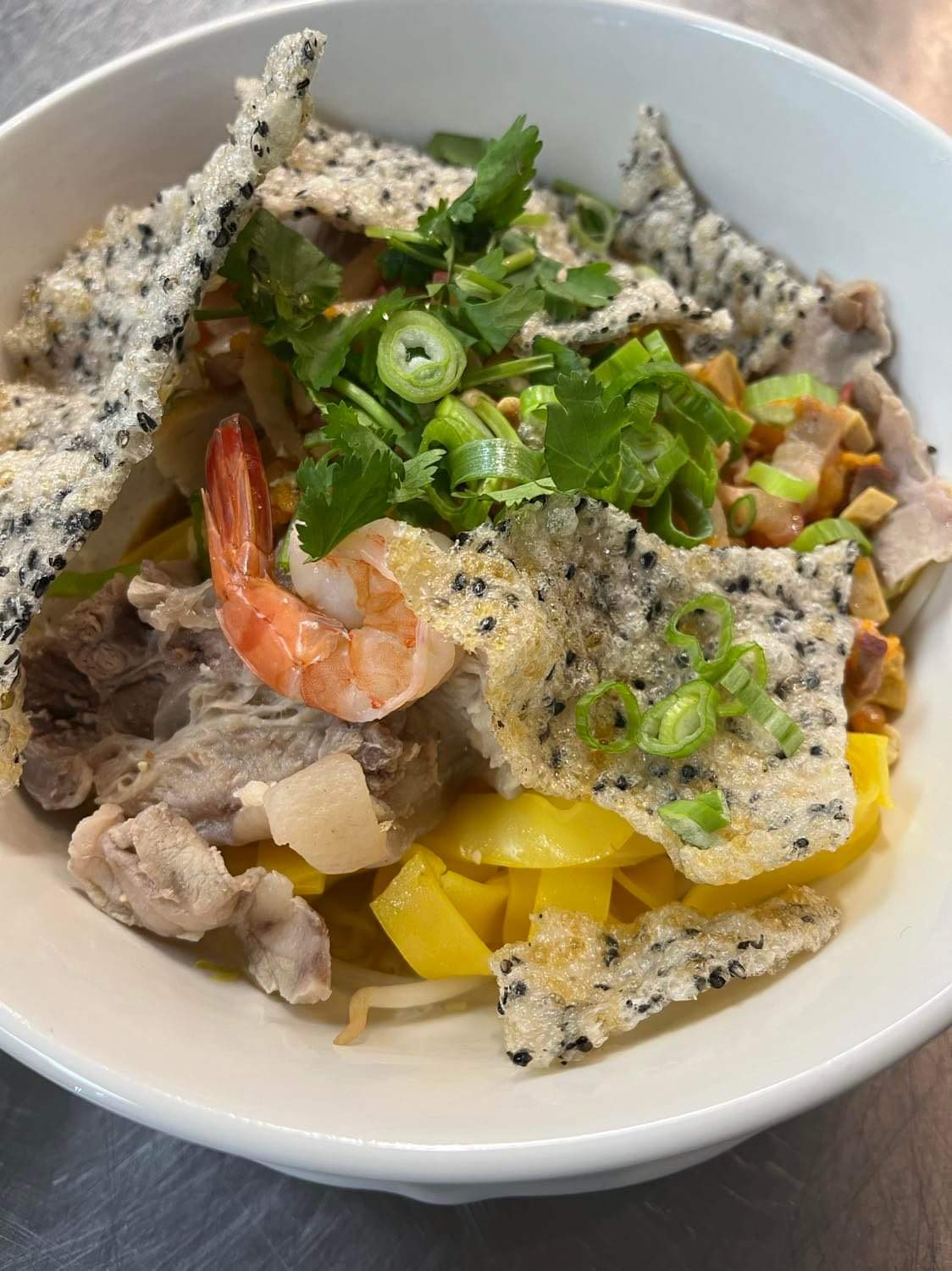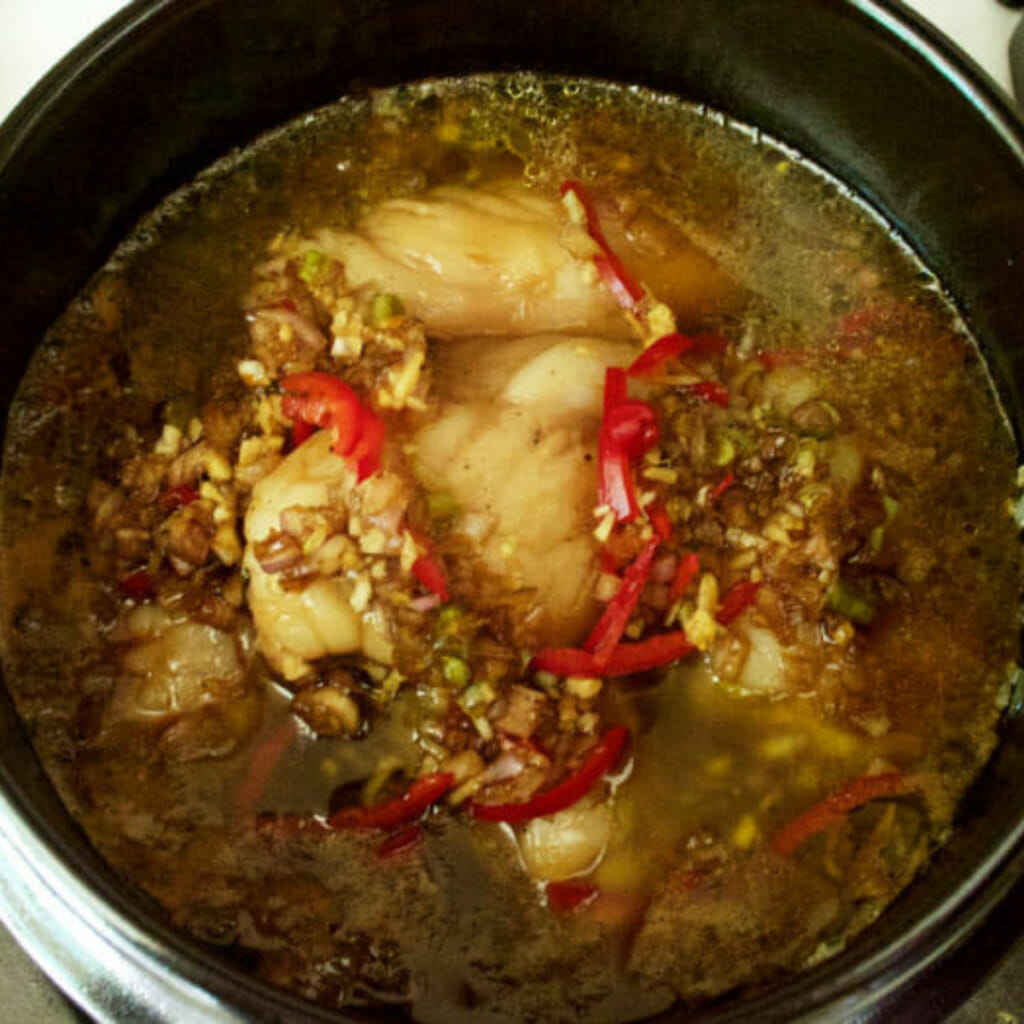Have you ever wanted to cook an authentic Vietnamese dish but didn’t know where to start?
Introducing mi quang soup: a delicious, hearty soup that is perfect for colder weather. This step-by-step guide will show you how to make this traditional dish using ingredients that are easy to find at your local grocery store.
What is Mi Quang Soup?
Mi Quang soup is a popular Vietnamese soup made from beef, shrimp, pork slices, peeled quails eggs and vegetables. Mi Quang is unique due to its mixed identity – it’s not quite noodle soup in the traditional sense, but not quite a dry vermicelli bowl either. Think of it as a “noodle soup” with about 1/4 of the broth, or a “salad” with noodles and a little broth at the bottom of the bowl.
By the way, if you love Vietnamese noodle soup, be sure to check out our other Vietnamese noodle soup recipe – Brisket Pho Noodle Soup Recipe. Just love Vietnamese food in general? Then you’ll love our Vietnamese Fresh Spring Rolls Recipe with Dipping Sauce as well!
Fun facts about Mi Quang
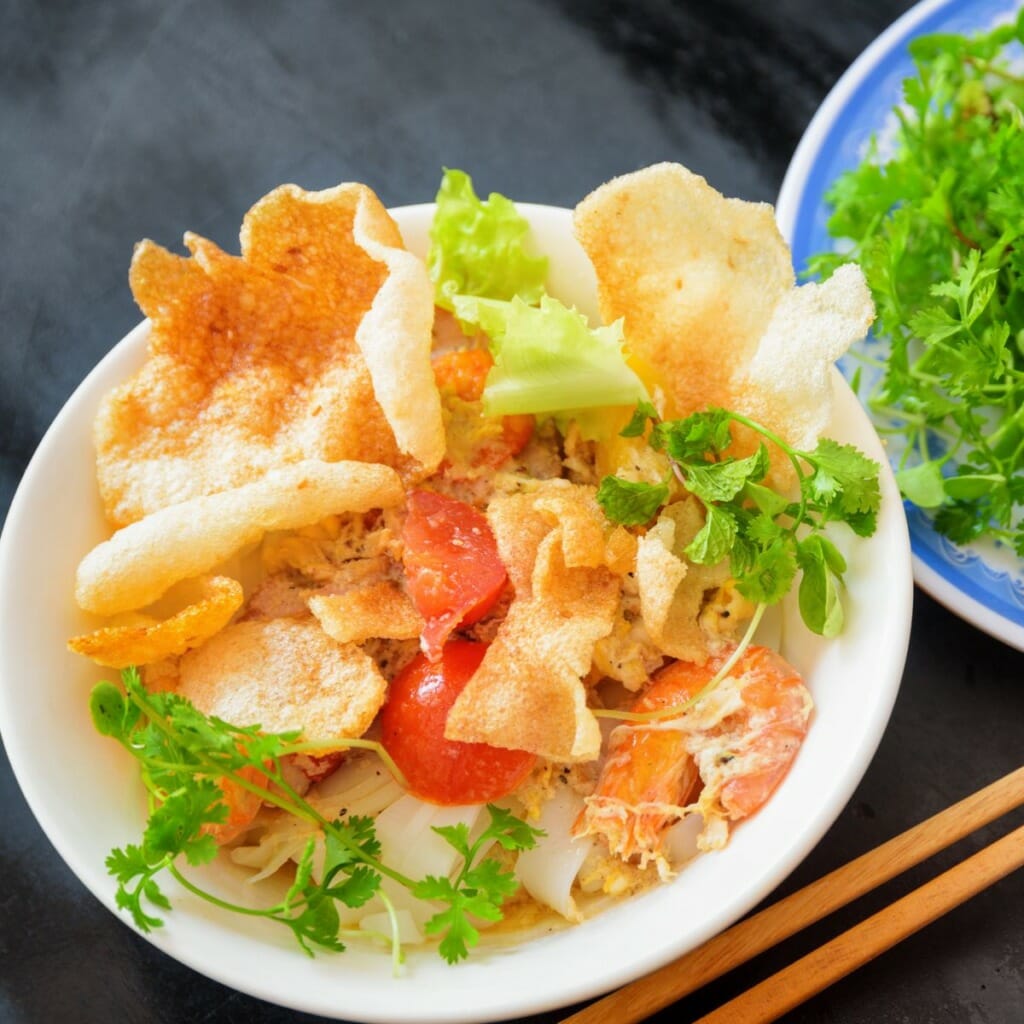
Mi Quang soup is a classic Vietnamese noodle dish that is popular in Quang Nam, Vietnam and can be made with natural shrimp and pork.
It is often served with roasted peanuts and crispy rice paper that have been seasoned in various ways to add flavor to the soup. Mi Quang soup has a characteristic rich flavor that makes it stand out from other types of soups.
Do they serve Mi Quang in Vietnamese restaurants in the States?
Yes, but not all. You have a better chance at scoring one of these bowls at a local Pho restaurant that aren’t in highly tourist areas.
Mi quang is an authentic Vietnamese dish that has become increasingly popular in the U.S. If you want to try it, go to a restaurant that caters to locals and not high tourism areas. In less “touristy” areas, Mi Quang will likely be on the menu, such as this Vietnamese restaurant in Quincy, Massachusetts.
In restaurants that cater to high tourism, they won’t have traditional dishes like mi quang because they’re trying to appeal to foreigners who may not know what they’re getting into. These restaurants are more likely to serve rice plates or pho instead – since those are less foreign tasting.
Rice plates and pho are both suitable for foreign palates (although some people might find them bland), so if you’re looking for something more adventurous, try mi quang! It might taste a little foreign at first—it’s a fish sauce (on Amazon)-based dish—but it’s worth the adventure!
Ingredients You’ll Need
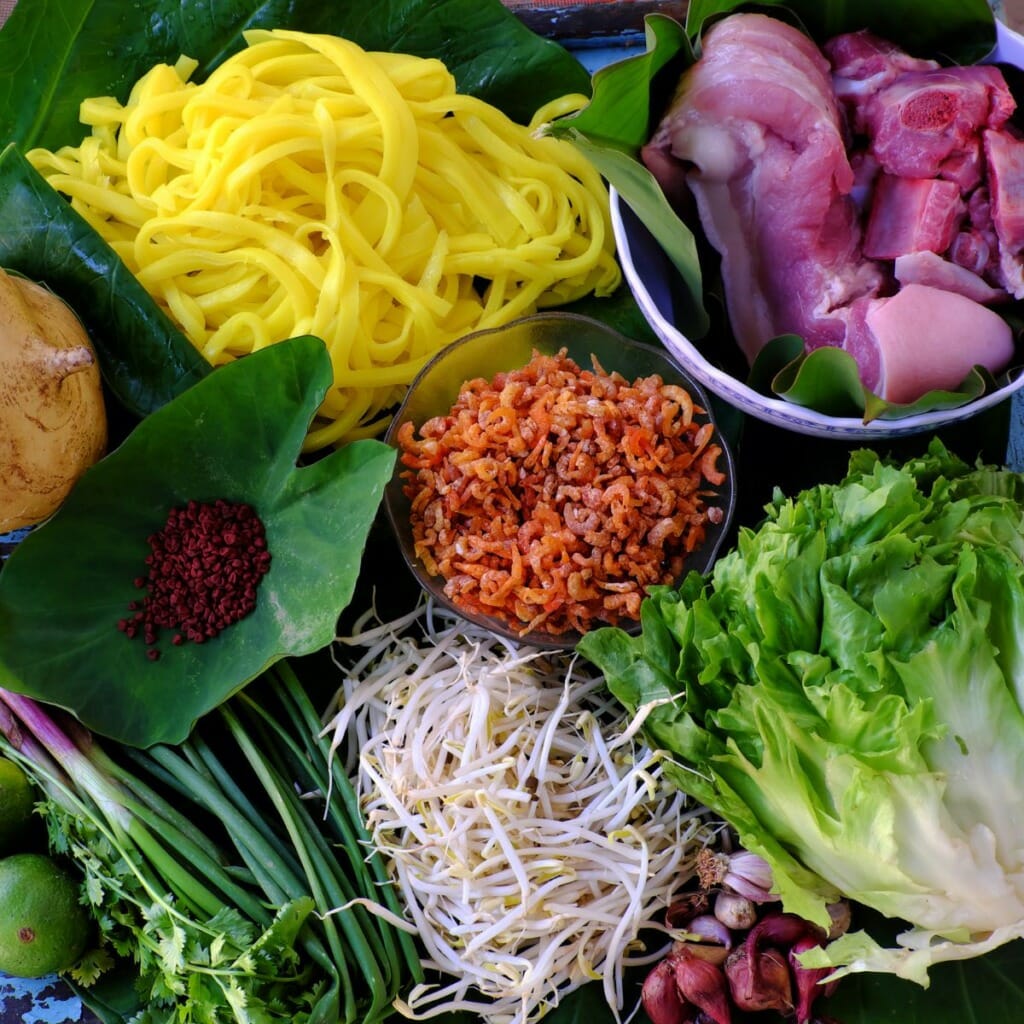
When making Vietnamese Mi Quang soup, here’s what you’ll need:
For the broth
- 2 pounds of pork neck bones (or St Louis style spareribs)
- 4 cups water
- salt, to taste
For the aromatic topping
- 6-8 large shrimp, peeled and deveined
- 1/2 pound pork belly, sliced into 1/4 inch crosswise (see image below for reference)
- 4-6 ounces of dried shrimp (on Amazon), roughly chopped
- 1/2 cup soup stock
- 1 shallot, minced
- 4 cloves garlic, minced
- 3 tablespoons fish sauce (on Amazon)
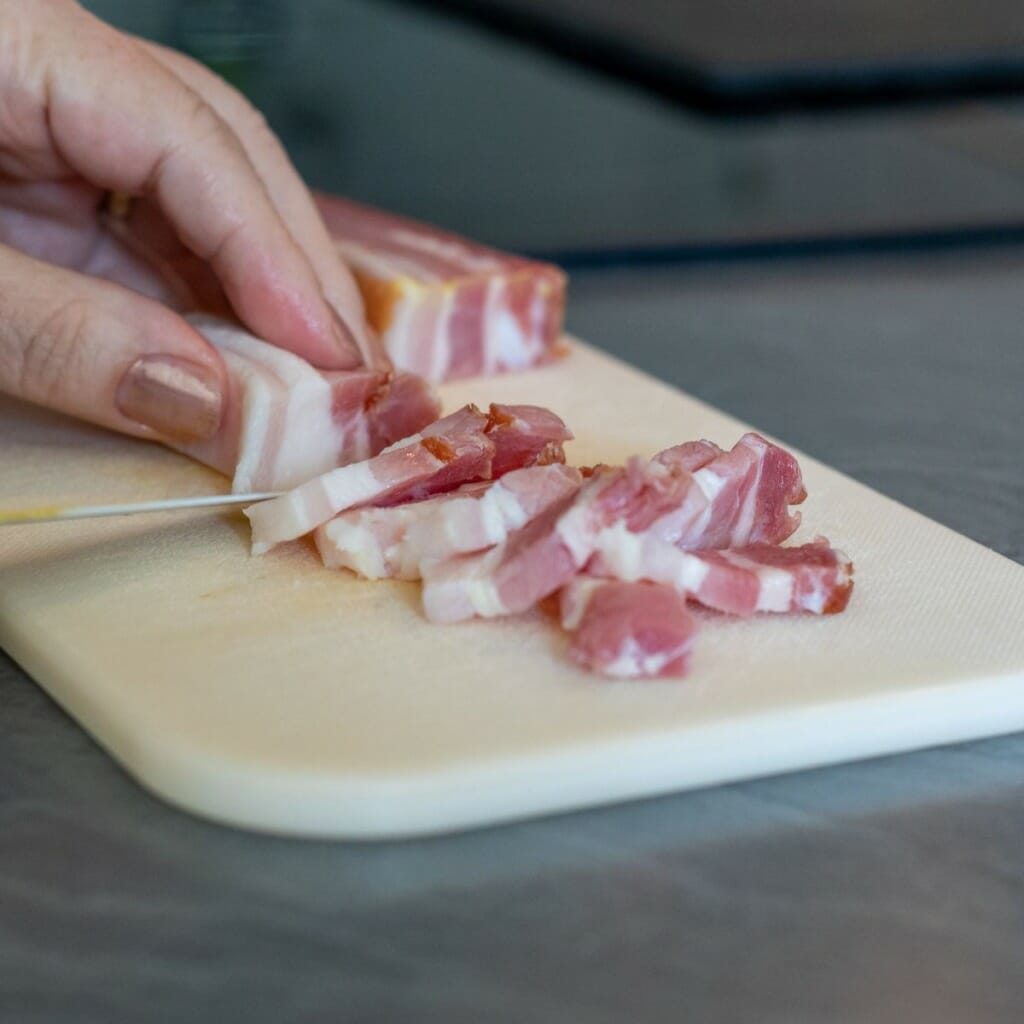
To Serve
- 2 packages of Mi Quang noodles
- 3 large sesame rice crackers, broken in large pieces
- peanuts, roasted and roughly chopped
- 16 ounces of bean sprouts
- shredded lettuce
- (optional) if you can find it – shredded banana blossoms (aka banana flowers)
- (optional) garnish with cilantro sprigs and chopped scallions
Instructions
For the simple broth:
- Rinse the pork neck bones in cold water thoroughly
- In a large stockpot, add the pork neck bones and enough water to slightly cover it, and bring to a boil. Let it go to a rolling boil for about 3 minutes – then immediately discard this water. I find that this is the best way to get rid of all the impurities that comes from boiling pork neck bones.
- Add bones back to the empty stockpot, add 4 cups of water, bring to a boil and lower immediately to a simmer. Let it simmer covered for 30 minutes to 1 hour.
- Add salt to taste, and discard the pork neck bones, reserving the broth for later
For the aromatic topping
- Heat 1 tablespoon oil over medium high heat, add garlic and shallots. Stir fry for 30 seconds to 1 minute, or until fragrant.
- Add pork belly, dried shrimp (on Amazon), and fresh shrimp. Cook for 3-5 minutes, until cooked all the way through.
- Add 3 tablespoons fish sauce (on Amazon) and lower the heat for 30 seconds.
Prep the noodle, rice cracker, and beansprout
- Cook the noodles according to package directions
- Immediately remove and rinse under cold water (this prevents the noodle from sticking together like a large glump)
- Optional – add 1/2 teaspoon olive oil and massage it into the noodle – this prevents further sticking once it cools completely.
- Microwave the rice cracker for 1minute in the microwave, turning halfway through. Break into large pieces.
- Cook the beansprouts by boiling it for 1 minute and immediately remove from water.
To serve:
- Make your bowl of mi quang by adding a layer of 1/2 cup cooked beansprouts, a handful of shredded lettuce, and banana blossom (if you have it!)
- Add the mi quang noodles on top of the veggies.
- Top with desired amount of aromatic broth – get some of that broth!
- Spoon a ladle of stock broth from step 1 into the bowl
- Top with roasted peanuts and rice cracker
You’ll need these for this recipe, on Amazon
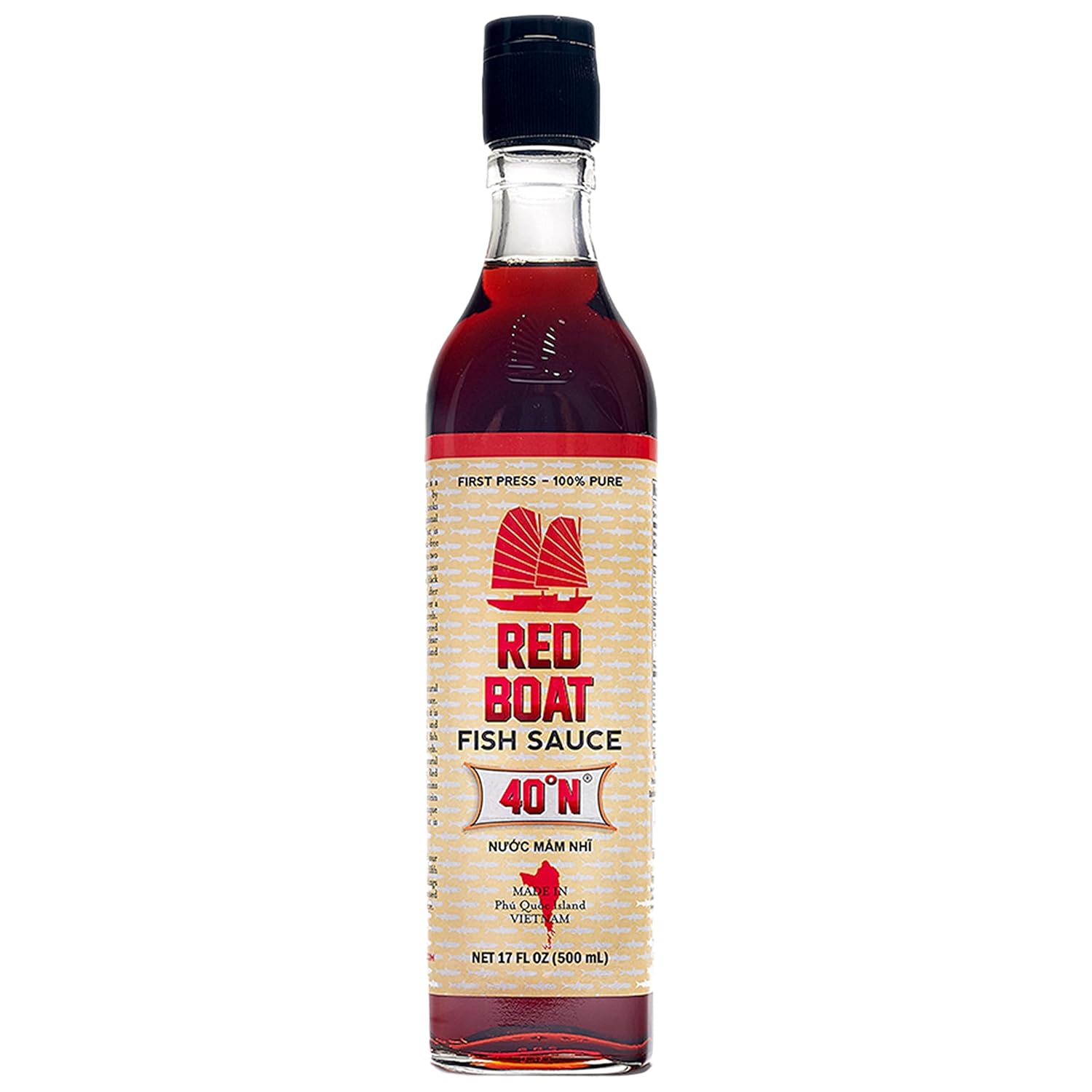 Buy Now →
Buy Now →  Buy Now →
Buy Now → (on Amazon)
Variations for Mi Quang recipe
There are many variations of the Mi Quang recipe that can be made. Variations include substituting ingredients such as pork, shrimp, or beef, and adding different herbs and spices to enhance the flavor. Additionally, in rural Vietnam where supermarkets don’t really exist, the natives would use whatever local ingredients are available at the time.
No shredded lettuce? Try red shredded cabbage. If you can find banana blossom, that’s even better! Banana blossom adds a nice crunch to every bite!
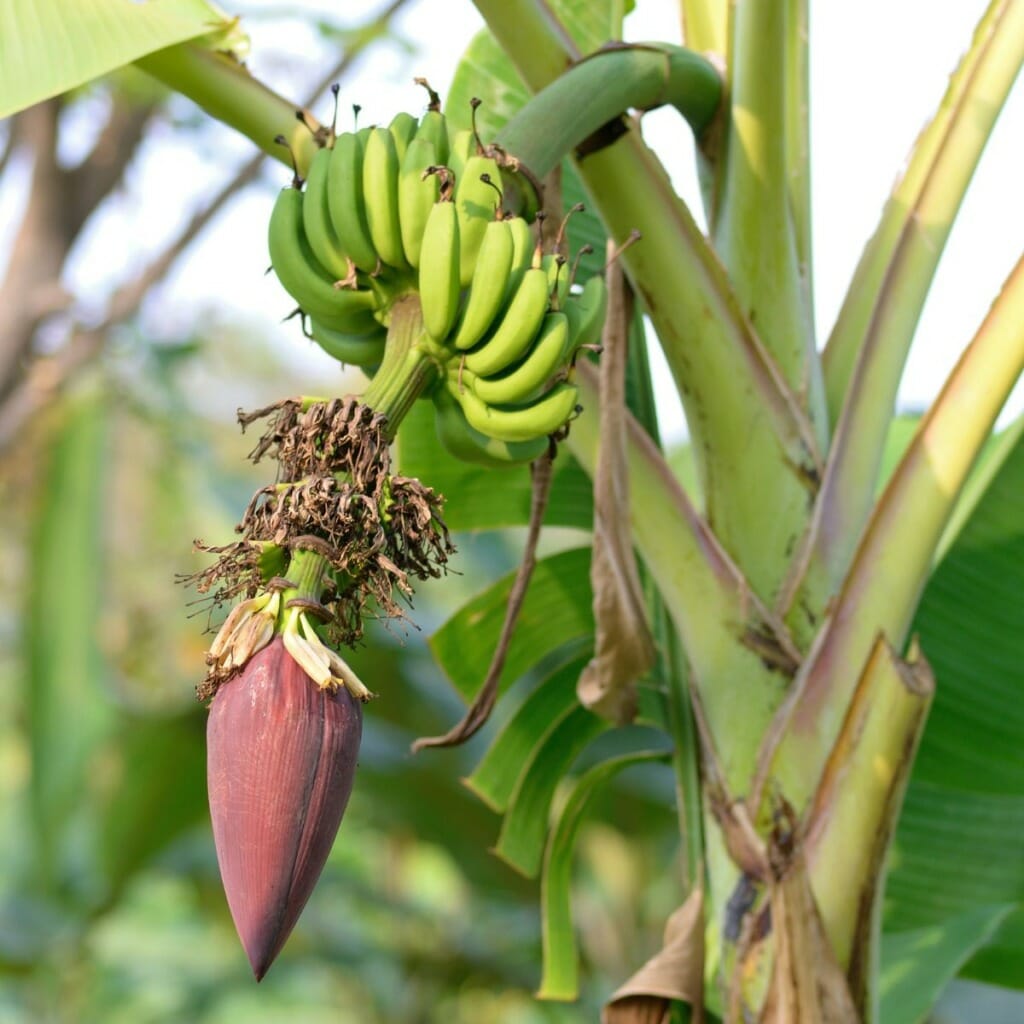
FAQ
Where does it originate?
Mi Quang soup is believed to have originated from the Quang province of central Vietnam. It has become a popular dish in the region and is traditionally served with pork slices, whole shrimp and peeled quails eggs on top of warm wide white rice noodles. The dish is garnished with crushed peanuts, scallion (spring onion) and chopped coriander before being topped with a strong pork and prawn stock or soup. Locals are proud to say that their mothers make the best mi quang!
What are some variations of mi quang?
Mi quang may also contain chicken or pig bones in its recipe in some regions. Depending on regional cooking preferences, other ingredients such as bean sprouts, fish sauce or garlic can be used to create unique flavor profiles in each variation of mi quang soup.u003cbru003eInstead of pork belly, you can also add or substitute for chicken thigh, sliced and chopped. I would not use chicken breast – there is no fat there and a good bowl of mi quang requires some chewy fat! Boneless chicken thighs would be the best substitute here.
What is the difference between mi quang soup vs. pho noodle soup?
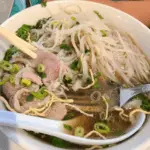
Mi Quang and Pho noodle soup are both very popular Vietnamese dishes. But there are some key differences between the two.u003cbru003eu003cbru003eu003cstrongu003eNoodlesu003c/strongu003e: Mi quang and pho are both rice noodles. The main difference is that mi quang is served with wide flat turmeric yellow noodle whereas pho is regular flat white noodles.u003cbru003eu003cbru003eu003cstrongu003eBroth:u003c/strongu003e Mi quang also has less broth than pho does – you don’t really see the broth in a bowl of mi quang until you start digging in!u003cbru003eu003cbru003eu003cstrongu003eToppingsu003c/strongu003e: Mi quang is topped with crushed peanuts, served with shrimp and quail eggs – whereas pho is typically served with beef slices and other beef meats such as flank, tripe (stomach lining) tendon, meatball, among others.
What are the unique features of mi quang soup?
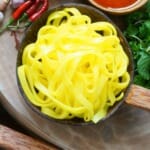
One of the most unique features about mi quang is the bright yellow noodles. They are soft yet firm and have a characteristic yellow colour due to the addition of turmeric powder. This noodle is specific to mi quang and isn’t typically used for anything else in Vietnamese cuisine.u003cbru003eu003cbru003eAnother unique feature is the amount of broth it is served with – most noodle soups have broth filled almost to the brim whereas mi quang is served with about 1/4 of that – you don’t even know it’s there until you start eating it!u003cbru003eu003cbru003eAnother unique feature is it is also served with crispy rice crackers and topped with crushed peanuts.u003cbru003e
Love Asian Food? Try one of these other recipes:

Vietnamese Mi Quang Noodle Soup
- Total Time: 1 hour 20 minutes
- Yield: 6 bowls 1x
Description
Mi quang noodle soup – authentic Vietnamese recipe
Ingredients
For the broth
- 2 pounds of pork neck bones (or St Louis style spareribs)
- 4 cups water
- salt, to taste
For the aromatic topping
- 6–8 large shrimp, peeled and deveined
- 1/2 pound pork belly, sliced into 1/4 inch crosswise (see image below for reference)
- 4–6 ounces of dried shrimp (on Amazon), roughly chopped
- 1/2 cup soup stock
- 1 shallot, minced
- 4 cloves garlic, minced
- 3 tablespoons fish sauce
To Serve
- 2 packages of Mi Quang noodles
- 3 large sesame rice crackers, broken in large pieces
- peanuts, roasted and roughly chopped
- 16 ounces of bean sprouts
- shredded lettuce
- (optional) if you can find it – shredded banana blossoms (aka banana flowers)
- (optional) garnish with cilantro sprigs and chopped scallions
Instructions
For the simple broth:
- Rinse the pork neck bones in cold water thoroughly
- In a large stockpot, add the pork neck bones and enough water to slightly cover it, and bring to a boil. Let it go to a rolling boil for about 3 minutes – then immediately discard this water. (I find that this is the best way to get rid of all the impurities that comes from boiling pork neck bones)
- Add bones back to the empty stockpot, add 8 cups of water, bring to a boil and lower immediately to a simmer. Let it simmer covered for 30 minutes to 1 hour.
- Add salt to taste, and discard the pork neck bones, reserving the broth for later
For the aromatic topping
- Heat 1 tablespoon oil over medium high heat, add garlic and shallots. Stir fry for 30 seconds to 1 minute, or until fragrant.
- Add pork belly, dried shrimp, and fresh shrimp. Cook for 3-5 minutes, until cooked all the way through.
- Add 3 tablespoons fish sauce and lower the heat for 30 seconds.
Prep the noodle, rice cracker, and beansprout
- Cook the noodles according to package directions
- Immediately remove and rinse under cold water (this prevents the noodle from sticking together like a large glump)
- Optional – add 1/2 teaspoon olive oil and massage it into the noodle – this prevents further sticking once it cools completely.
- Microwave the rice cracker for 1minute in the microwave, turning halfway through. Break into large pieces.
- Cook the beansprouts by boiling it for 1 minute and immediately remove from water.
To serve:
- Make your bowl of mi quang by adding a layer of 1/2 cup cooked beansprouts, a handful of shredded lettuce, and banana blossom (if you have it!)
- Add the mi quang noodles on top of the veggies.
- Top with desired amount of meat!
- Spoon a ladle of stock broth from step 1 into the bowl
- Top with roasted peanuts and rice cracker and optional garnishings such as cilantro and chopped scallions.
Notes
1. You can substitute the pork neck bones for other thick cuts of pork such as st. louis style spareribs, but I find that it’s much cheaper to use pork neck bones. Typically you can find these for $1.49-$2/lb at a oriental market. Save spareribs for a yummy barbecue instead!
2. You can substitute the broth with store-bought chicken, pork, or beef broth, or even make your own batch of bone broth (see recipe here)
3. If you can help it, I would not substitute the noodle for anything else since it’s one of the main attraction of this dish. However, I understand it’s hard to find – I couldn’t even find it on Amazon. If you must, look for wide flat rice noodles (think noodles that look like “chow mein”).
4. You might wonder why we boil the pork neck bones and immediately discard the water – if you’ve never cooked pork neck bones before, this is a valid curiosity! I find that there’s a lot of gray impurities when you boil pork neck bones for the first time. By discarding this first, what you end up with is a clearer broth that’s nice and sweet and flavorful – and no “grayish” looking broth!
- Prep Time: 1 hour
- Cook Time: 20 minutes
- Cuisine: vietnamese
